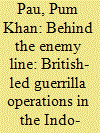| Srl | Item |
| 1 |
ID:
165194


|
|
|
|
|
| Summary/Abstract |
The paper probes the formation of local Levies among the indigenous hill people of the Indo-Burma frontier and their contributions to the British-led guerrilla operations during the Second World War. With the shift of the theatre of the Southeast Asian edition of the Second World War from the Lower Burma plains to the mountainous hilly terrain in the Indo-Burma frontier, the mode of warfare also changed. In the new terrain where conventional warfare was no longer suitable the British Indian Army resorted to guerrilla tactics largely with the support of the indigenous hill people who had the traditional expertise in guerrilla fighting. However, the valour and heroism of the indigenous hill people behind the enemy lines has not received adequate scholarly attention. This paper discusses the case of three ethnic communities in the Indo-Burma frontier – Kachin, Naga and Zo (Kuki-Chin) – who were considered by the British as ‘loyal allies’ at the risk of Japanese atrocities. Supervised by British civil and military officers the local Levies not only effectively bogged down the Japanese forces in the frontier but also supplied valuable intelligence to the Allied force in the reconquest of Burma. The paper argues that Kachin, Zo and Naga rallied behind their colonial masters with the hope that they would receive reward from the latter after the war.
|
|
|
|
|
|
|
|
|
|
|
|
|
|
|
|
| 2 |
ID:
185505


|
|
|
|
|
| Summary/Abstract |
In the absence of pre-colonial written records, reconstruction of the history and identity of indigenous tribes has to depend on oral stories and the documentation of the ‘other’, while the former is subject to distortion, the latter is often glossed with vested interest. Taking the case of the indigenous tribes of the India-Burma-Bangladesh borderlands, this paper probes the representation of the Zo (Kuki-Chin) people in colonial ethnography, on one hand, and to what extent colonial knowledge was informed by ‘investigative’ or ‘survey modality’, which, in fact, was solely for administrative purpose, on the other. It argues that indigenous tribes of the India-Burma-Bangladesh borderlands were represented as completely fragmented in colonial ethnography, however, behind the colonial policy of classification one can still unearth the ethnic commonality of the various tribes when they are seen through the lens of cultural similarity or as a ‘culture area.’
|
|
|
|
|
|
|
|
|
|
|
|
|
|
|
|
| 3 |
ID:
115884


|
|
|
|
|
| Publication |
2012.
|
| Summary/Abstract |
The article is an attempt to study the history of the Tedim Road, a 265 km transborder road connecting Imphal (the capital of Manipur in India) with Tedim in the Chin Hills (Chin State) in western Burma (Myanmar). It was constructed by the British solely for the purpose of facilitating military movements along the India-Burma frontier during the Second World War. Although it is yet to receive adequate scholarly attention, the historical significance of the Tedim Road as part of the larger Allied plan for the reconquest of Burma after it was lost to the Japanese in the early 1940s cannot be overlooked. The article attempts to analyse encounters between the Allied and the Japanese on this road. It argues that the historical events that occurred on the Tedim Road and the participation of the indigenous tribes of the India-Burma frontier in the war made a significant contribution to ensuring the withdrawal of the Japanese from the Indian frontier.
|
|
|
|
|
|
|
|
|
|
|
|
|
|
|
|